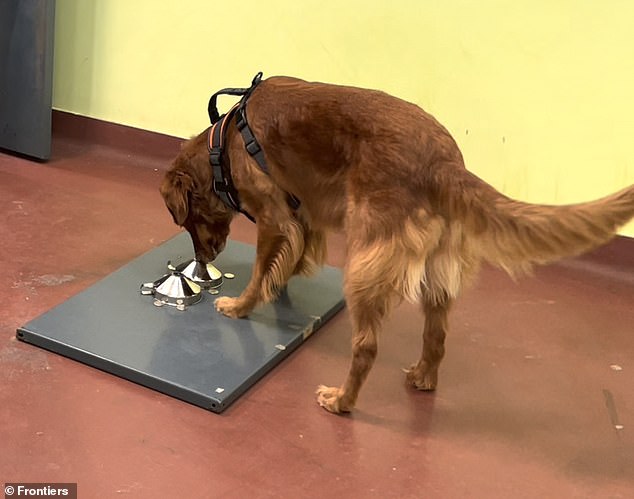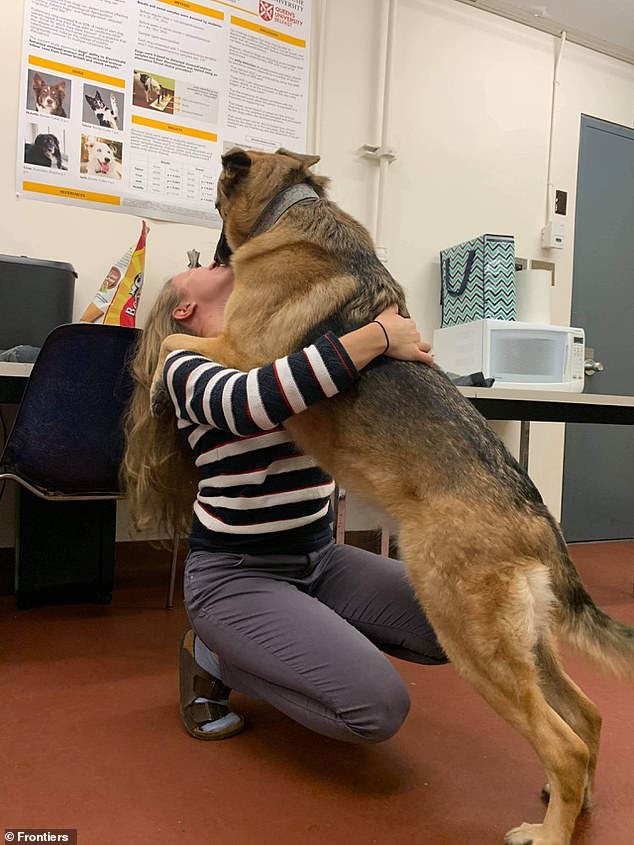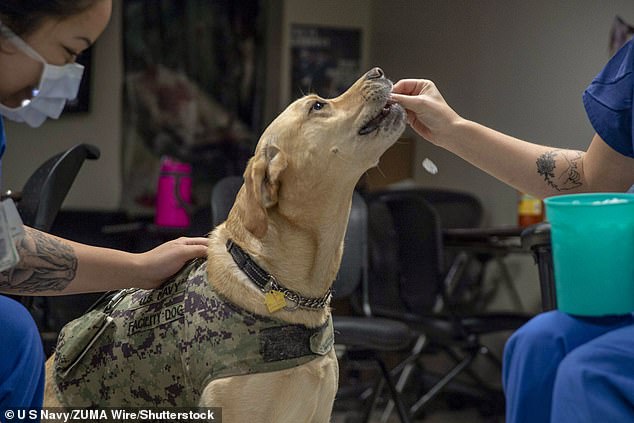Their sensitive noses can detect an impending seizure, detect signs of Covid and even expose cancer.
Now, scientists have successfully trained two dogs to sniff out the trauma of a person’s breath.
Researchers trained 25 dogs to detect chemical signs of stress in a person’s breath.
However, only two had sufficient skills and motivation to complete the study: Ivy, a red Golden Retriever, and Callie, a German Shepherd/Belgian Malinois mix.
In the future, scientists believe these talented dogs could identify when someone is about to have a frightening flashback.

Researchers trained 25 dogs to detect chemical signs of stress in a person’s breath. However, only two had sufficient skills and motivation to complete the study. Pictured: Ivy, a red golden retriever


In the future, scientists believe these talented dogs could identify when someone is about to have a frightening flashback. Pictured: Callie, a German Shepherd/Belgian Malinois mix.
Post-traumatic stress disorder arises from exposure to a traumatic event and can cause debilitating symptoms that include re-experiencing the event in the form of a flashback.
Currently, service dogs are used to help patients with PTSD by alerting and interrupting when their companions are struggling with their symptoms.
By training dogs to recognize the signs of an episode solely from their breath, scientists hope service dogs can intervene sooner and keep their companions safe.
Researchers at Dalhousie University in Canada recruited 26 people who had gone through some type of trauma as scent donors for their study.
Half of the participants had been diagnosed with post-traumatic stress disorder (PTSD), a mental health condition that is triggered by a frightening event.
To donate scents, participants attended sessions in which they were reminded of their traumatic experiences while wearing different masks.
One mask provided a calm breath sample, while the other provided an “objective” breath sample that they wore as they recalled their ordeal.


The dogs learned to detect volatile organic compounds in human breath that indicated that a PTSD episode was imminent. This could help them intervene earlier at work as service dogs (file image)
Meanwhile, the scientists recruited 25 dogs to train them in odor detection.
Both were trained to recognize the “target” odor and were presented with a series of samples to see if they could accurately detect the stress odors.
All human beings have an olfactory profile composed of volatile organic compounds (VOCs) that are determined by our genetics, age and other variables.
Previous studies have suggested that dogs can smell VOCs associated with human stress.
Scientists at Queen’s University Belfast trained dogs to detect stress in sweat and breathing with an accuracy of 93.75 percent.
However, this is the first study to show that dogs can also sniff out chemical signatures associated with PTSD.
First author Laura Kiroja says, “Both Ivy and Callie found this work intrinsically motivating; their unlimited appetite for delicious treats was also a plus.”
“In fact, it was much harder to convince them to take a break than to start working.”
During tests with donated masks, both dogs were able to discriminate between stressed and non-stressed samples with 90 percent accuracy.
And, in tests with pure VOC samples, Ivy achieved 74 percent accuracy and Callie achieved 81 percent accuracy.
Ms Kiiroja said: “Post-traumatic stress disorder service dogs are already trained to help people during episodes of distress.
«However, dogs are currently trained to respond to physical and behavioral cues. Our study showed that at least some dogs can also detect these episodes through breathing.’
Further analysis revealed that Ivy was more likely to identify participants who were feeling particularly anxious, while Callie was more likely to identify when people were feeling embarrassed.
“Although both dogs performed with very high accuracy, they seemed to have a slightly different idea of what they considered a ‘stressed’ breath sample,” Ms Kiiroja said.
“We speculate that Ivy was tuned to hormones of the sympathetic-adrenal-medullary axis, such as adrenaline, and Callie was tuned to hormones of the hypothalamic-pituitary-adrenal axis, such as cortisol.”
The researchers said their findings, published in the journal Frontiers in Allergy, could one day lead to trained dogs interrupting PTSD episodes at an earlier stage, making their interventions more effective.
